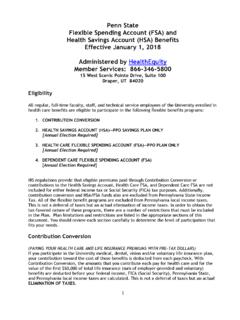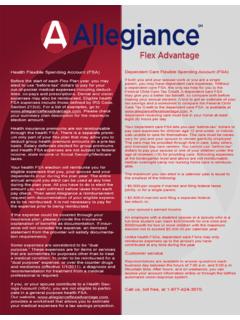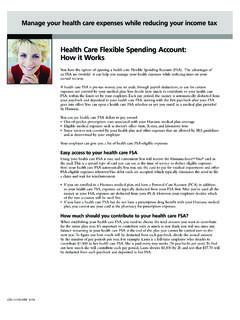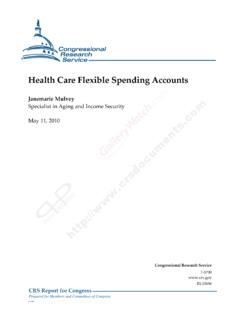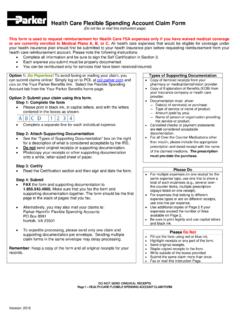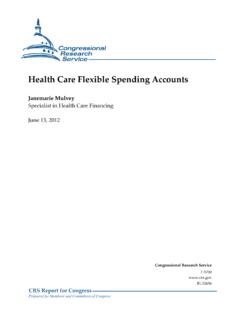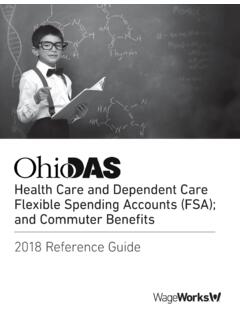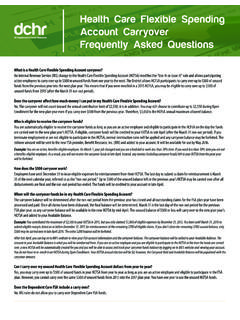Transcription of Health Care Flexible Spending Account (HFSA) Dependent ...
1 Health Care Flexible Spending Account (HFSA) Dependent Care Flexible Spending Account (DFSA)IN THIS GUIDE: PAGES ummary of Benefits 2 Eligibility 3 When You May Enroll 3 Making Annual Election(s) 3 Annual Cut-Off Date for Enrollment in Current Year 3 When Participation Begins 3 Making Changes 4If You Take a Leave of Absence 5 When Your Employment Ends 5 How the Flexible Spending Accounts Work 6 How Much You Can Contribute 6 Limitations and Restrictions 6 Additional Limitations on Dependent Care FSA Contributions 7 The Tax Advantages 7 Impact on Other Benefits 8 Your Flexible Spending Account Statements 8 Your HFSA 9 Eligible Health Care Expenses 9 Ineligible Health Care Expenses 11 Your DFSA 12 Eligibility 12 Who Qualifies as a Dependent 12 Eligible Dependent Care Expenses 12 Ineligible Dependent Care Expenses 12 Claiming Reimbursement
2 13 Paying for HFSA Expenses 13 Information About Your Debit Card 14 When You Can File Claims 14 Where to Find Claim Forms 14 Documenting Your Claim 15 Reimbursement 15 Qualified Reservist Distributions 15 Year End Balances 16 How to Appeal a Denied Claim 16 General Information About the Plan 17 Amendment or Termination of the Plan 17 Plan Documents 17 The Navy Exchange Service Command (NEXCOM) offers the opportunity for regular Associates to save on qualified out-of-pocket medical and Dependent expenses through participation in the Health Care Flexible Spending Account (HFSA), the Dependent Care Flexible Spending Account (DFSA) or both. The FSA Plan is an important part of the comprehensive total compensation and benefits package that you are offered as a NEXCOM of the most important features of the Plan is that participation is an excellent way for you to save on Health and Dependent care costs while lowering your Federal income and Social Security (FICA) taxes.
3 We hope you are able to take advantage of this valuable benefit J. Bianchi Rear Admiral, Supply Corps, USN (Ret.) Chief Executive Officer Navy Exchange Service Command 1 IntroductionSummary of BenefitsHealth Care FSA (HFSA) Dependent Care FSA (DFSA)Your maximumannual contribution$2,600$5,000 See Additional Limitations on Dependent Care FSA Contributions on page 7 Your minimum annual contribution$200$200 Annual claim submission deadlineAll claims incurred January 1 through December 31 must be received by PayFlex by April 30 of the following claims incurred January 1 through December 31, including any grace period claims, must be received by PayFlex by April 30 of the following yearJanuary 1 through December 31 January 1 through December 31 Grace periodNo grace 1 through March 15 of the following yearCarryoverMay carry over up to $500 each yearNoneA Flexible Spending Account (FSA) allows you to set aside a portion of your pay in a special Account . You can then use the money in your Account (s) to reimburse yourself for qualified Health care and/or Dependent care expenses.
4 Your taxable pay is reduced by the amount you set aside in your Account (s) so you pay lower income taxes and Social Security taxes. There are two types of in the FSAs is voluntary. You decide whether you would like to participate and how much money you would like to set aside, within the minimums and maximums shown below. 23 EligibilityRegular full-time and part-time Associates are eligible to participate in NEXCOM s Flexible Spending Account (s). You do not need to be enrolled in a NEXCOM medical plan to participate. Participation is completely voluntary. FSA(s) can be used to reimburse your tax-qualified dependents eligible expenses, as well as your own. When You May Enroll Annual Enrollment: Enrollment in an FSA(s) is an annual event. During each Annual Enrollment Period, you should review your out-of-pocket expenditures, determine if you would like to participate in an FSA(s), and make an annual election for the upcoming year. The elections you make will be in effect for the following Plan Associates: You have 31 days from your date of hire or the date you are eligible to participate in the FSAs.
5 Your election stays in effect until the end of that Plan year. If you do not enroll when initially eligible, you must wait until the Annual Enrollment Period. Qualified Family Status Changes: If you have a qualified family status change ( , divorce, birth of a child, etc.), you may enroll in an FSA within 31 days of the event. Otherwise, you must wait until the next Annual Enrollment Period. See Making Changes section on page 4. Making Annual Election(s)Annual elections will be divided into 26 pay periods ( , $500 annual election = $ per pay period), unless you are a newly hired Associate. Newly hired Associate s contributions will be based on the number of remaining pay periods in the completed enrollment form authorizes NEXCOM to deposit a portion of your earnings into your FSAs before taxes are deducted. Federal law requires that whatever annual election you make cannot be changed throughout the applicable Plan year unless you have a qualified family status change.
6 Annual Cut-Off Date for Enrollment in Current YearEffective October 1 through December 31 of each Plan year, actions listed below will not be allowed for the current year: Enrollments due to a new hire event or a qualified family status change Increases in contributions due to a qualified family status change When Participation Begins New Associates For a newly hired (or newly eligible) Associate, participation begins the date you enroll within your 31-day eligibility period. Employment in an eligible position or any eligible status changes (employment category and/or qualifying event) that occur after September 1 will require a participation election before the October 1 annual cut-off date of the current year. Contributions will begin the first day of the next pay period following enrollment. You must complete the enrollment process to participate. Annual Enrollment If you enrolled during the Annual Enrollment Period, your annual election will go into effect on January 1.
7 EligibilityMaking Changes The IRS requires that your FSA elections stay in effect throughout the full Plan year. Once made, you can t change your election during the year unless you experience a qualified family status change. The following are examples of qualified family status changes: Marriage Divorce Birth or adoption of a child Death of a spouse, child or parent (providing that the parent is a qualified Dependent and claimed on your Federal Tax Form) Termination of your spouse s employment Commencement of your spouse s employment Transition from part-time to full-time work, or from full-time to part-time work, by you or your spouse Loss of medical coverage An unpaid leave of absence taken by you or your spouse For Dependent Care Only: Change in cost of coverage, such as a significant increase or decrease in the charge by your current Dependent care provider (unless the provider is a relative), or change in provider ( , going from paying a provider to not paying a provider or no longer needing a Dependent care provider).
8 The change in your FSA election must be due to and consistent with the change in your family status. For example, within 31 days of the birth or adoption of a child, you could enroll in the Health Care FSA if you were not already enrolled or if you were enrolled, you could increase your current annual election for the Health Care FSA, but you could not reduce or stop your contributions. You should contact your local Human Resources Representative immediately after the change takes place to make sure you allow yourself enough time to take the appropriate action. If you do not make the qualified family status change within the 31-day period, you will not be allowed to make the change until the next FSA Annual Enrollment Period. 45 EligibilityIf You Take a Leave of Absence Paid Leave of Absence Your participation in the FSAs will not be affected if you are granted a paid leave of absence. Payroll deductions will continue, and you can still use your FSAs to reimburse yourself for eligible expenses.
9 You may elect a qualified family status change, as explained in Making Changes, if your change in election is consistent with the circumstances of your leave. Unpaid Leave of Absence During an unpaid leave of absence: Your contributions and participation in the Health Care and/or Dependent Care FSA will stop on the first day of the absence. You can continue to be reimbursed from your Health Care and/or Dependent Care FSA for eligible expenses you incurred while you were actively at work. You will not be reimbursed for expenses incurred during the leave of absence. Any balance in your Account from contributions made before your leave can be used for claims incurred upon your return to work. Upon return from an unpaid leave of absence: When you return, the contributions required to meet your election for the Plan year will be recalculated (and therefore will increase) over the remaining pay periods in the year. Health Care FSA (HFSA): You will be reinstated fully in the HFSA (retroactive to the date your absence began).
10 After reinstatement, you may request reimbursement for expenses incurred anytime in the year when enrolled. Dependent Care FSA (DFSA): You will be reinstated in the DFSA as of the date of your return. You may request reimbursement for expenses incurred anytime in the year when actively participating, except those incurred during a period of unpaid leave of absence. When Your Employment Ends HFSA If your employment ends during the year, your contributions to your HFSA end. However, you can still be reimbursed for eligible expenses you incur up to your last day worked, provided your Account balance is sufficient. You have until April 30 of the next year to submit claims. DFSA If your employment ends during the year, your contributions to your DFSA end. However, you can still be reimbursed for eligible expenses you incur up to your last day worked, provided your Account balance is sufficient. You have until April 30 of the next year to submit claims. If You Are Rehired If you separated from employment and are rehired within the same calendar year, your bi-weekly election for your FSA(s) will be reinstated.


